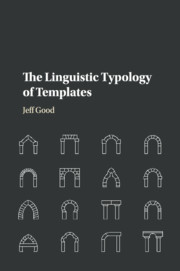Book contents
- Frontmatter
- Contents
- List of figures
- List of tables
- Acknowledgments
- Glossing abbreviations
- 1 Defining template
- 2 A typological description language for templates
- 3 Typologizing templates: case studies
- 4 Typologizing templates: comparison
- 5 Moving forward
- Appendix Specification of template description language
- References
- Author index
- Author index
- Term index
2 - A typological description language for templates
Published online by Cambridge University Press: 05 February 2016
- Frontmatter
- Contents
- List of figures
- List of tables
- Acknowledgments
- Glossing abbreviations
- 1 Defining template
- 2 A typological description language for templates
- 3 Typologizing templates: case studies
- 4 Typologizing templates: comparison
- 5 Moving forward
- Appendix Specification of template description language
- References
- Author index
- Author index
- Term index
Summary
The language of linear stipulation
Descriptive linguistics has long relied on categories like prefix, enclitic, verb second or head final to refer to grammatical categories combining linear ordering restrictions with other morphophonological or morphosyntactic properties. For example, a prefix is conventionally understood as an element that is both morphologically dependent on a stem and which appears before the stem in a linear sequence. This is opposed to the more generic term affix, and the existence of so-called mobile affixes (see Section 1.5) suggests that, even if there is a strong tendency for morphological dependency and fixed order between dependent and host, this is not an absolute necessity. Similarly, a category like head final references a linearly defined generalization over classes of phrases in a given language delimited by the fact that they contain a syntactic head.
From the perspective of the present study, hybrid categories like these cannot be considered “basic” but rather are a kind of grammatical “chimera,” and I will refer to them as chimerics here in order to emphasize the non-necessary nature of the pairing of a linear specification with other, logically independent grammatical properties. The ubiquity of such categories appears to have obscured an important gap in the conceptual and terminological foundations of linguistic description: the lack of a truly generalized vocabulary to categorize patterns of linear stipulation independent of other grammatical features. To continue with the two examples of chimerics just discussed, in the present context, it is important to keep track of the fact that the terms prefix and head final both imply the existence of a linguistic constituent where an element taken to be more dependent (whether this is an affix or a non-head syntactic constituent) precedes an element taken to be less dependent (whether this is a stem or a syntactic constituent serving as a head). Each category may belong to quite distinct grammatical domains in traditional terms, but they share a significant aspect of what one might call their “linear grammar.”
Chimeric categories are so deeply embedded in the way linguists analyze grammatical patterns that it may not be immediately obvious why a generalized vocabulary for linear stipulation is needed, or what it would even look like, without a concrete example.
- Type
- Chapter
- Information
- The Linguistic Typology of Templates , pp. 40 - 103Publisher: Cambridge University PressPrint publication year: 2016

